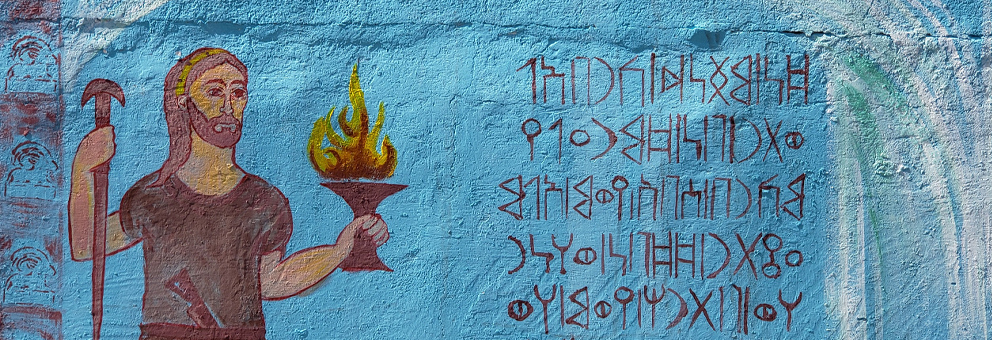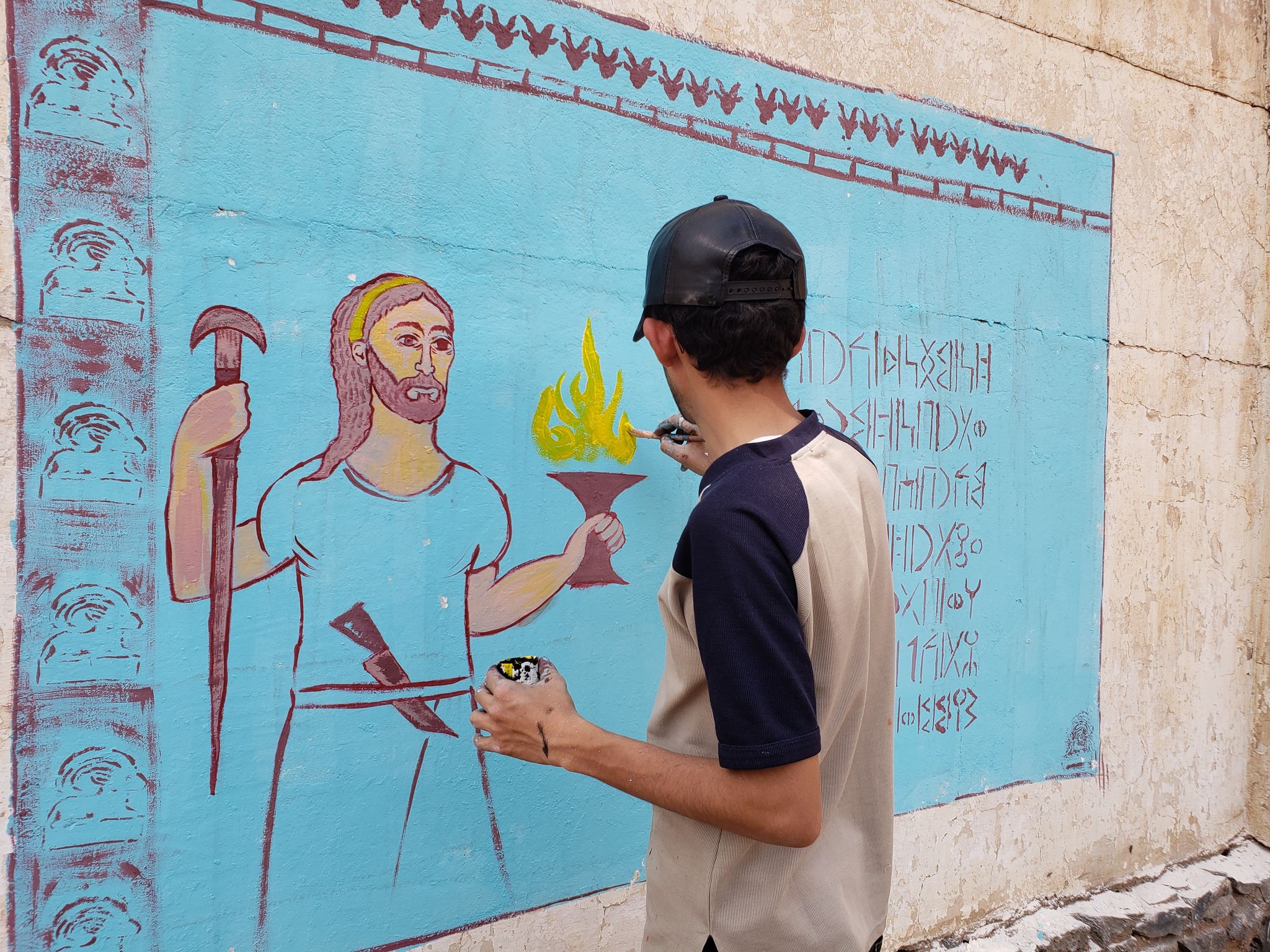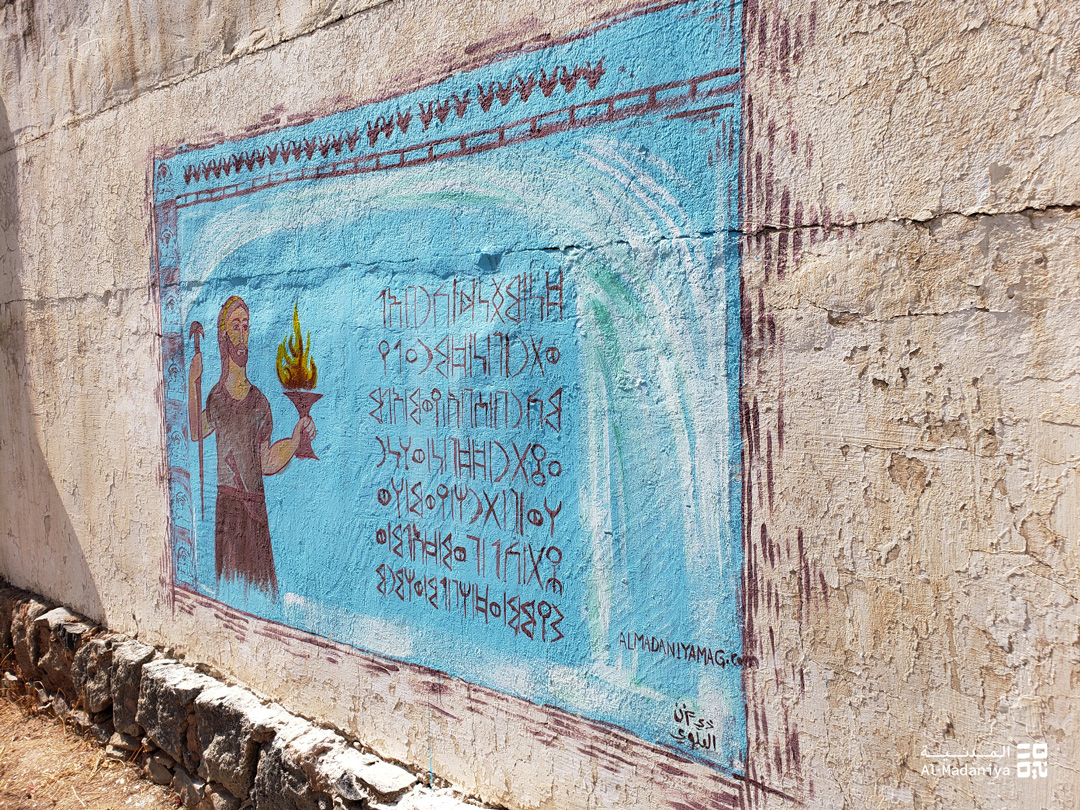
This post is also available in: العربية (Arabic)
I recently completed research examining the popular folktale Siirat Sayf bin Dhi Yazan (The Tale of Saif ibn Dhi Yazan),[1] which despite its relevance to the regional heritage and to Yemen’s history and culture since medieval times, has not gained the attention it deserves. The tale of Dhi Yazan’s life continues to hold suggestions and connotations about political and cultural life in contemporary Yemen as this character is often cited in the context of Yemen’s relationship, and the relationship of its ruling political elites, with other countries. The names Saif and Dhi Yazan are often cited in connection with Yemen, and in recent years some press sites have referenced the tale of Saif ibn Dhi Yazan when discussing the Nile River water crisis between Egypt and Ethiopia. In the popular folktale, Saif ibn Dhi Yazan fought the Ethiopians to guarantee Egypt access to the Nile River and to obtain the magical Book of the Nile.
The hero in history books
The character of Saif ibn Dhi Yazan raises many problems, not only at the level of the popular folkloric imagination but also in terms of the historical reality and its realistic dimension. The problems that this character poses from the historical dimension perspective date back to Islamic historians’ disagreements over its designation, on the one hand, and the absence of archaeological inscriptions, on the other, that would date this important period in Yemen’s history to the sixth century AD (the period that Saif ibn Dhi Yazan most likely lived, which directly precedes the rise of Islam).
The broad outlines of the tale are agreed upon by most sources of Islamic history and those who came after them, the contemporary scholars of the history of ancient Yemen. The Islamic sources, such as the books of al-Tabari, al-Masoudi, Ibn Hisham, al-Hamdani, and even Ibn Khaldun, agree that this Dhi Yazan descendant of historical Yemeni kings (Aqyal) led the resistance against the Ethiopian occupation, and attempted to seek the help of Rome’s Caesar in expelling the Ethiopians. However, his attempt ended in failure, so he went to Khosrow I who provided him with 800 prisoners to fight alongside him, headed by a Persian commander named Wahrez. Two hundred prisoners drowned along the way, but this Dhi Yazan descendant was able to defeat the Ethiopians with the aid of the remaining prisoners and the Yemeni tribes that allied with him. He killed the last of their surviving kings, Masrūq ibn Abraha, and expelled the Ethiopians from Yemen. The king took over for a while before his assassination by his Ethiopian guards. Yemen then came under the control of the Persians until the emergence of Islam.

Among various historians’ statements, I found myself drawn to the opinion of Abu Muhammad al-Hasan al-Hamdani, who wrote about Yemen’s history and its Hamdani tongue.[2] He states in his encyclopedia Al-Ikleel that Nu’man bin Afeer, the middle son of Zar’ah bin Afeer the eldest—his line ends with Saif ibn Dhi Yazan—is the one who rose to power in Yemen after the killing of Dhi Nawas and led the people’s resistance against the Ethiopian presence in Yemen, and that he was the one who sent his son, Amr ibn al-Nu`man, to seek the help of Caesar and the tribes of Qahtan in the Levant. And when his mission failed, the encyclopedia states that it was he who sent his other son, Saif ibn al-Nu`man (Aba al-Mundhir) to Khosrow I, and that the latter is Saif ibn Dhi Yazan—the lineage dating to his great-grandfather—who led the battle of liberation and became the king of Yemen. And thus, it was him that the delegations of Arabs, including Abd al-Muttalib bin Hashim, went to congratulate.
The tale of Dhi Yazan as told by the popular folkloric imagination
The folktale of Saif ibn Dhi Yazan is assumed to have begun in the 14th century AD when a new struggle between the Arabs and the Ethiopians took place during the Mamluk era. The conflict provided material for a new incentive for the Arab popular imagination to alter and fabricate events, so the events and details formed a wealth of additional material to the news and stories that had been repeated since the sixth century AD. The storytellers and narrators of this era had by then acquired technical tools and sufficient knowledge and experience that formed the folktale, which developed into its own independent literary genre. These conditions provided a suitable climate for manifesting the tale of King Saif, developing it and giving it characteristics from that time period.

Missions assigned by popular imagination to the hero, Saif ibn Dhi Yazan
At the historical level, the character of Saif ibn Dhi Yazan had undertaken the task of freeing Yemen from its Ethiopian conquerors and restoring the kingdom to the Himyarites. At the level of popular folkloric imagination, however, this character was assigned goals both larger and more dangerous; missions that, if accomplished, would transcend the temporal and spatial limits of this character in its realistic dimension.
First: Spreading Islam. From the tale’s first lines, the narrator summarizes this mission and defines it as follows: “As of yet, this is the story of Prince Saif ibn Dhi Yazan, the exterminator of the infidels, of the people of polytheism and of tribulations in all regions and times. He is the one who will put an end to evil magic and disorder… et cetera. ”[3] This pre-emptive phrase, which is used as a promotional tactic to attract and captivate the reader, attempts to summarize the first mission and main purpose of King Saif ibn Dhi Yazan, which is to spread Islam and exterminate all infidels, polytheists, sorcerers and evil. This goal is not restricted to a limited place or a specific time, but rather it extends to “all regions and times”.
Second: Controlling the Nile. There is another mission, no less important and dangerous than the first, assigned to Saif ibn Dhi Yazan. He seeks, through a series of epic events, to obtain The Book of the Nile that will grant its owner power to control the course of the river and divert it to any place they desire. This book is even more dangerous because it was in the hands of the evil king of the Ethiopians, who used it to prevent the flow of the Nile River, to transfer its course and deprive the people of Egypt of its water. So Saif ibn Dhi undertook a series of adventures and heroic tasks to get The Book of the Nile, and he was finally able, with the help of good magicians and loyal jinn, to form a new path for the river to enable the Nile to flow once again to Egypt and rebuild the country. And thus, “The saga affirms that Saif ibn Dhi Yazan carried out a unique mission. For he is one who built cities and rerouted the flow of the Nile River from the land of the Ethiopians to the lands of Egyptians. That is, his mission is one for the learned hero, or if you will, the founder of the Egyptian civilization.”[4]
God’s grace and loyal helpers of humans and jinn
Despite the superior abilities and heroic traits conferred on Saif ibn Dhi Yazan in this tale, he nevertheless cannot complete his missions, achieve his goals and objectives, and overcome risks and obstacles that threaten his life and obstruct his path to his goals, without the help of his faithful assistants and followers. They range from loyal jinn, good-hearted sorcerers and righteous people, in addition to other mythical characters and magic tools, such as the board that controls genie Ayrood, Plato’s hood and the charmed whip, the sword of Sam ibn Noah, and the enchanted belt. And at the forefront of Saif ibn Dhi Yazan’s helpers is the providence of God Almighty that protected and nurtured him from an early age.

The importance of the tale of Saif ibn Dhi Yazan
The folktale of Saif ibn Dhi Yazan is of remarkable importance even among similar tales that have been shaped by centuries of folkloric imagination in the region. The Russian Arabist Flinchitsky says that “The tale of Saif ibn Dhi Yazan is among the best examples of Arab folk literature”.[5] He believes that, “this epic can compete in terms of richness of content, diversity, attractiveness of plot and artistry of narration, not only with the best oral tales and epic folktales, but it can even compete with international medieval prose models, such as those found in the famous tales of the One Thousand and One Nights”.[6]
Farouk Khorshid believes that the tale of King Saif “occupied a prominent place among popular folktales and attained immense popularity in the areas of public reception”.[7] He goes on to say that it “is a surviving literary document that presents a clear picture of what the rich Arab imagination could attain in terms of creativity and innovation, as well as skill in drawing lively situations full of symbols. It accurately depicts the state of a human seeking knowledge and undergoing a life-long battle to obtain it”.[8] And so for him it is “something unique, in terms of folktales specifically, and Arabic literature in general”.[9]
Shawky Abdel Hakim says that, “It can be said that if there exists a multi-level tale composed within Arab folk literature, then the tale of King Saif ibn Dhi Yazan al-Hamiri is without a doubt one”.[10] In his opinion, this tale does not chronicle the lives and wars of the last known Yemeni kings from a genealogical perspective, but rather “can be considered from one of its facets and angles a national formula, as it elaborates on the history of the conflict and wars between the Semites and the Hamites, or between the Arabs of the south of the island in Yemen and southern Arabia, and their African neighbors of black-skin In Ethiopia, Sudan, and Africa in general”.[11]
It is noticeable that the maturity of this tale comes from the fact that it surfaced at a later time, when folktales had developed as a narrative genre, and it became more complex and entrenched in these artistic traditions, benefiting from previous experiences. This also helped make it into an artistic model, influenced and inspired by many creative and contemporary works of poetry and fiction.

Research Concepts
I based my research study on the theories of narrative discourse, particularly the structural approach of oral narrators, in order to analyze the narrative characteristics of this folktale. I also relied on Mikhail Bakhtin’s concept of ‘hybridity’ and Julia Kristeva’s concept of ‘intertextuality’ to provide further openness to the text and understand epic accumulations linked to the process of the narration through centuries and various locations until the tale finally reached the printing presses in the 20th century. My research went through the following stages, summarized below.
First: Choosing one version from the available printed versions of this tale. I managed to obtain four different printed editions of the folktale, each of which differs in size as well as place and date of publication. I read and compared these copies in an effort to determine the difference between them and what distinguishes each version from the other. I then chose the version issued by Egypt’s General Authority for Culture Palaces in 1999, introduced by Professor Khairy Shalaby,[12] to be our main source of data, given the completeness of this version of the tale. It is also free of contradictions, and was issued by a well-known scientific institution. As for the other versions, they were referred to as secondary sources in the study.
Second: The textual study. I sought, by studying the narrative discourse of the text according to the modern textual approaches referred to above, to show what distinguishes it from other similar folklore texts produced in the Arab Middle Ages. I also sought to survey the narrative mechanisms adopted by oral narrators in communicating this tale to the listeners. Here began the study of the narrative vision and of the timeline, characters, and roles of external narrators or performers, and of the stylistic features such as omission and syntax and others. The purpose of our analysis of the textual interaction between this tale and other cultural texts is to understand this specific tale, which was the product of a collective imagination with a national character, and the different cultural elements that contributed to its features and general historical and cultural connotations.

Conclusion
Among the conclusions of this study is that word-of-mouth, as a single channel for receiving the text, has played an important role in shaping the structure of the speech, organizing its elements, and determining the relationships that arise between these elements. The narrator’s relationship to the audience contributes also to drawing out the features of the speech in this tale. This text was verbally recited for centuries during certain social gatherings in Arab cities, such as Cairo, the cities of Upper Egypt and others. These textual indications of oral narrative show how unlikely it is that the text could have been simply fabricated by typographers in the 20th century. One of the concerns of the study of discourse is situating the text within the context of time and place, and to reveal its formative attributes that would point to its characteristics as a cultural text that resulted from aesthetic, political and cultural human needs.
The tale of Saif ibn Dhi Yazan is of cultural importance. This is, hence, an invitation to the cultural and academic circles in Yemen to give this text the attention it deserves by studying it from various angles. This can only be accomplished when these institutions overcome their view of folk culture as inferior. This culture is a reservoir of memories to which is connected the meaning of a nation’s existence and the cultural identities that strike in to the depth of history.
[1] This article summarizes key points from my Ph.D. studies at Sana’a University. Professor Abdul Aziz Al-Maqaleh and Professor Muhammad Al-Nahari supervised my dissertation. See Khaled Yahya Al-Ahdal, Bunyat al-Khitab fi Sirat al-Malek Saif bin Dhi Yazan (The Structure of Speech in the Tale of King Saif ibn Dhi Yazan), unpublished doctoral dissertation, Faculty of Arts, University of Sana’a, 2013.
[2] Abu Muhammad al-Hasan al-Hamdani: Kitab al-Ekleel min Akhbar al-Yaman wa Ansab Hamir (From the News of Yemen and the Lineages of Himyarites) – Muhammad Ali al-Akwa – published by Yemen’s Ministry of Culture – Ed 2004 m – vol 2 p. 201.
[3] Sirat Fares al-Yaman al-Malek Saif Vin Dhi Yazan: Al-Batal al-Karrar wal-Fares al-Mighwar sahib al-batsh wal-Iqtidar al-Ma’rouf bil-Ghazwat al-Mashhurah (The Tale of the Knight of Yemen, King Saif ibn Dhi Yazan: The Hero and the Warrior Knight, the Strong and Powerful Known for his Famous Invasions), The General Authority for Culture Palaces, Library of Folk Studies, Cairo, 2nd Edition, 1999, Ch. 1, p. 7.
[4] Fil’shtinskii, I.M , (in Arabic) Seif ibn Dhi Yazin’s Epic and Heroic Romance Part of the Soviet Studies of Arabic Literature, Dar Al-Taqaddum, Moscow, 1978, p.83.
[5] Fil’shtinskii, I.M , p.61.
[6] Fil’shtinskii, I.M , p. 62.
[7] Farouk Khorshid, Adwa’ ‘Aala al-Sira al-Sha’biya (Spotlight on Folktales), Iqra’ Publications, Cairo, p. 119.
[8] Khorshid, p. 134.
[9] Khorshid, p. 139.
[10] Shawky Abdel Hakim, Al-Siyar wal Malahem al-Sha’biyah al-‘Arabiyah (Tales and Arab Folk Epics), Dar Al Hadathah, Beirut, 1st Edition, 1984 AD, p. 109.
[11] Abdel Hakim, p. 109.
[12] Sirat Fares al-Yaman al-Malek Saif Vin Dhi Yazan: Al-Batal al-Karrar wal-Fares al-Mighwar sahib al-batsh wal-Iqtidar al-Ma’rouf bil-Ghazwat al-Mashhurah (The Tale of the Knight of Yemen, King Saif ibn Dhi Yazan: The Hero and the Warrior Knight, the Strong and Powerful Known for his Famous Invasions) – The General Authority for Culture Palaces, Library of Folk Studies, Cairo, 2nd Edition, 1999, ‘Four volumes’, presented by Khairy Shalaby.




